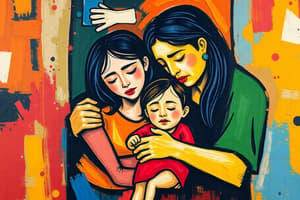Podcast
Questions and Answers
What is the primary focus of the supporter role in a community?
What is the primary focus of the supporter role in a community?
- Guiding people through confusing situations and bringing order to chaos
- Learning about the community and its members to improve personal relationships
- Maintaining order and enforcing laws
- Providing compassionate and reassuring presence to those in need (correct)
In what type of situation would the stabilizer role be most necessary?
In what type of situation would the stabilizer role be most necessary?
- A routine traffic stop
- A community event or festival
- A disaster recovery effort (correct)
- A community member's personal tragedy
What is the primary goal of the supporter in learning about the community?
What is the primary goal of the supporter in learning about the community?
- To establish a sense of authority in the community
- To improve their own capabilities and confidence
- To increase their own personal knowledge
- To better understand the community's needs and provide support (correct)
What is the primary characteristic required of the stabilizer in a critical situation?
What is the primary characteristic required of the stabilizer in a critical situation?
Which role is most closely associated with law enforcement duties?
Which role is most closely associated with law enforcement duties?
What is the primary trait required for the enforcer role?
What is the primary trait required for the enforcer role?
What is an example of a situation that requires the enforcer role?
What is an example of a situation that requires the enforcer role?
Which component of the criminal justice system is responsible for enforcing laws and maintaining civil order?
Which component of the criminal justice system is responsible for enforcing laws and maintaining civil order?
What is the primary function of the court system in the criminal justice system?
What is the primary function of the court system in the criminal justice system?
Which component of the criminal justice system is responsible for providing rehabilitation services to offenders?
Which component of the criminal justice system is responsible for providing rehabilitation services to offenders?
Which of the following is a critical aspect of the law enforcement component of the criminal justice system?
Which of the following is a critical aspect of the law enforcement component of the criminal justice system?
Which of the following is an example of a victim that is not an individual?
Which of the following is an example of a victim that is not an individual?
What is the primary benefit of incorporating procedural justice into law enforcement practices?
What is the primary benefit of incorporating procedural justice into law enforcement practices?
Which of the following is a key element of the procedural justice approach?
Which of the following is a key element of the procedural justice approach?
What is the primary reason for consistently applying rules in a fair and equitable manner?
What is the primary reason for consistently applying rules in a fair and equitable manner?
What is the primary goal of involving groups in the decision-making process?
What is the primary goal of involving groups in the decision-making process?
What is the primary characteristic of impartial decision-making in the procedural justice approach?
What is the primary characteristic of impartial decision-making in the procedural justice approach?
What is the primary purpose of the 'Listen' component in the LEED framework?
What is the primary purpose of the 'Listen' component in the LEED framework?
What is the main benefit of applying the LEED framework in daily police work?
What is the main benefit of applying the LEED framework in daily police work?
Which of the following is an example of the 'Dignity' component of the LEED framework?
Which of the following is an example of the 'Dignity' component of the LEED framework?
What is the primary goal of the 'Equity' component in the LEED framework?
What is the primary goal of the 'Equity' component in the LEED framework?
What is the primary reason for practicing unbiased policing?
What is the primary reason for practicing unbiased policing?
What is the primary difference between explicit and implicit bias?
What is the primary difference between explicit and implicit bias?
What is the primary characteristic of implicit bias?
What is the primary characteristic of implicit bias?
What is prejudice, according to the text?
What is prejudice, according to the text?
What is the difference between prejudice and discrimination?
What is the difference between prejudice and discrimination?
What is the primary outcome of negative stress?
What is the primary outcome of negative stress?
Which of the following is a response to a potentially dangerous situation?
Which of the following is a response to a potentially dangerous situation?
What is the primary function of the freeze response?
What is the primary function of the freeze response?
What is a characteristic of not all stress being negative?
What is a characteristic of not all stress being negative?
What is the primary characteristic of routine stress?
What is the primary characteristic of routine stress?
Which type of stress is typically short-lived?
Which type of stress is typically short-lived?
What is the primary characteristic of traumatic stress?
What is the primary characteristic of traumatic stress?
What is the typical outcome for people who experience traumatic stress?
What is the typical outcome for people who experience traumatic stress?
What is the primary condition necessary for traumatic stress to occur?
What is the primary condition necessary for traumatic stress to occur?
What is the primary characteristic of compassion fatigue?
What is the primary characteristic of compassion fatigue?
What is the primary difference between secondary trauma and compassion fatigue?
What is the primary difference between secondary trauma and compassion fatigue?
Flashcards are hidden until you start studying
Study Notes
Roles in the Community
- The Supporter role involves helping people who are grieving, hurt, or experiencing a personal tragedy, requiring a compassionate and reassuring presence.
- As a Supporter, you may need to calm a lost child, help a confused person with Alzheimer's, or interview someone who has gone through severe trauma.
- To effectively fill the Supporter role, it's essential to learn about the community and its people, which can be achieved by reaching out to community members.
- Building relationships with community members will also increase the likelihood of them reaching out to you for support.
The Stabilizer
- The Stabilizer role requires displaying confidence to calm others in critical incidents, such as disaster recovery and responding to traffic crashes.
- As a Stabilizer, you must maintain your composure and guide those who are struggling to remain calm, bringing order to uncontrolled situations.
The Enforcer
- The Enforcer role involves duties typically associated with law enforcement, such as making arrests and maintaining order by giving lawful commands.
- As an Enforcer, you need to be assertive and give orders rather than ask questions.
- Although the Enforcer role is necessary, the majority of your time will be spent as the Supporter and Stabilizer.
The Criminal Justice System
- The criminal justice system maintains and enforces criminal laws, involving structures, functions, and decision-making processes of agencies dealing with crime and criminals.
Components of the Criminal Justice System
- The three main components of the criminal justice system are:
- Law Enforcement
- The Courts
- Corrections
Law Enforcement
- Enforces laws
- Maintains civil order
- Protects the constitutional rights of everyone within the United States
The Court System
- Interprets laws
Corrections
- Enforces punishment and rehabilitation services as defined by the court system
Involved Parties in a Crime
- A complainant is a person who reports a crime or alleges that a crime has been committed.
- A witness is any person who has information about some element of the crime or about evidence or documents related to the crime.
- A victim is a person or entity that suffers an injury as a result of a crime, which can involve physical harm, loss of money, loss of property, or damage to property.
Confidental Sources and Persons of Interest
- A confidential source is a person who provides information in confidence about a crime, and their identity is normally not disclosed unless required by law.
- A person of interest is someone involved in a criminal investigation who has not been arrested or formally accused of a crime, often cooperating with the investigation or having information that can help.
Suspects and Offenders
- A subject is a known person accused or suspected of committing a crime, but may not have actually committed the crime.
- A suspect/detainee is the person believed to have committed a crime, identifiable through:
- Direct observation
- Indirect witness observations and statements
- The suspect's own statements
- Evidence collected during the investigation
- An arrestee is a person who is under arrest or has been arrested.
- A defendant is a person formally accused of committing a crime or a civil wrong in a court proceeding.
- An offender is a person convicted of a crime in a court of law.
Procedural Justice in Law Enforcement
- Procedural justice focuses on carrying out justice in a fair and equitable manner to increase compliance and positive views of law enforcement.
- When people believe they have been treated justly, they are more likely to comply with laws and have a positive view of law enforcement.
Pillars of Procedural Justice
- Fairness and Consistency: Consistency in decision-making and treating people with respect is key to perceived fairness, not just outcomes.
- Voice and Representation: Involve groups in decisions that affect them and listen to their concerns to ensure they feel represented.
- Transparency and Openness: Decisions should be made without secrets and deception to promote trust.
- Impartiality and Unbiased Decision-Making: Decisions should be based on relevance and data, avoiding biases.
Procedural Justice in Police Work
- To practice procedural justice, use the LEED framework in daily police work
- The LEED framework consists of four components: Listen, Explain, Equity, and Dignity
LEED Framework Components
- Listen: give everyone a chance to tell their side of the story
- Explain: always explain your actions to the people you interact with
- Equity: make fair decisions in all interactions
- Dignity: treat people with respect and dignity
Bias and Unbiased Policing
- Bias is the unfair treatment and attitude towards a group of people, considered unethical behavior
- Unbiased policing ensures equal treatment of individuals, regardless of race, ethnicity, religion, gender, sexual orientation, socioeconomic status, national origin, homeless status, mental or physical disability, age, or other self-defining characteristic
Types of Bias
- Explicit bias: a conscious dislike of certain groups, often manifesting as openly hateful and biased actions
- Implicit bias: an unconscious prejudice, not recognized by the individual, influencing judgments about others
- Implicit bias is present in everyone, regardless of education level, class level, age, or other factors
- Our brains make unconscious associations, influencing our judgments and decisions
Key Principles of Unbiased Policing
- Decisions based on evidence and data, rather than emotions and predetermined ideas
- Fair and impartial treatment of all individuals, without discrimination or prejudice
Stereotyping and Its Consequences
- Stereotyping involves judging a group of people based on personal opinions or experiences, which can be unfair and harmful.
- Both positive and negative stereotypes are harmful because they categorize people unfairly.
Impact on Law Enforcement
- Judging individuals based on stereotypes can lead to missed valuable information and clues, potentially hindering investigations and putting lives at risk.
- Law enforcement officers should avoid prejudice and discrimination to maintain effective relationships with the communities they serve.
Prejudice and Discrimination
- Prejudice is an unjustified and baseless attitude toward a person based on their membership in a social group.
- Prejudices can stem from learned behavior and attitudes.
- Discrimination occurs when people act on their prejudices, leading to harmful consequences and potential liability.
Consequences of Discrimination
- Discrimination can break down relationships between law enforcement and the communities they serve.
- It can also lead to liability and negative outcomes.
Stress
- Stress is a physical or emotional reaction to an event or situation, which can be perceived or real.
- Stress can be a physical or mental response to a demanding situation or change.
Effects of Negative Stress
- Slows reaction time
- Makes you question your decisions
- Clouds your judgment
Positive Stress
- Can make you aware of a potentially dangerous situation
- Prepares you to react
Fight-Flight-Freeze Response
- Fight: body prepares to face the danger head-on
- Flight: body prepares to get away from a dangerous situation
- Freeze: body fails to react
Types of Stress
- Routine stress is a normal part of daily life, often involving ordinary tasks and responsibilities.
- Examples of routine stress include being an officer, balancing home and work, and taking care of day-to-day tasks.
Acute Stress
- Acute stress is short-lived and occurs when experiencing unexpected changes in life.
- Examples of acute stress include the end of a relationship, the death of a family member, or sudden unemployment.
Traumatic Stress
- Traumatic stress occurs during major events that threaten personal safety or the safety of others.
- Examples of traumatic stress include war, disasters, incidents of assault, or other similar events.
- Most people who experience traumatic stress are able to recover, but some may be at risk of developing post-traumatic stress disorder (PTSD).
Secondary Trauma
- Also known as vicarious trauma, occurs when a person is exposed to the trauma of others and develops physical or mental impacts
- Can result in absences at work, inability to focus on tasks, and a shortened career
Compassion Fatigue
- Emotional exhaustion that comes from helping others on a long-term basis
- Symptoms include:
- Irritation
- Withdrawal from social situations
- Feeling emotionally drained
Studying That Suits You
Use AI to generate personalized quizzes and flashcards to suit your learning preferences.




